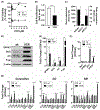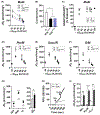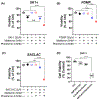Alterations in sphingolipid composition and mitochondrial bioenergetics represent synergistic therapeutic vulnerabilities linked to multidrug resistance in leukemia
- PMID: 34888943
- PMCID: PMC9058980
- DOI: 10.1096/fj.202101194RRR
Alterations in sphingolipid composition and mitochondrial bioenergetics represent synergistic therapeutic vulnerabilities linked to multidrug resistance in leukemia
Abstract
Modifications in sphingolipid (SL) metabolism and mitochondrial bioenergetics are key factors implicated in cancer cell response to chemotherapy, including chemotherapy resistance. In the present work, we utilized acute myeloid leukemia (AML) cell lines, selected to be refractory to various chemotherapeutics, to explore the interplay between SL metabolism and mitochondrial biology supportive of multidrug resistance (MDR). In agreement with previous findings in cytarabine or daunorubicin resistant AML cells, relative to chemosensitive wildtype controls, HL-60 cells refractory to vincristine (HL60/VCR) presented with alterations in SL enzyme expression and lipidome composition. Such changes were typified by upregulated expression of various ceramide detoxifying enzymes, as well as corresponding shifts in ceramide, glucosylceramide, and sphingomyelin (SM) molecular species. With respect to mitochondria, despite consistent increases in both basal respiration and maximal respiratory capacity, direct interrogation of the oxidative phosphorylation (OXPHOS) system revealed intrinsic deficiencies in HL60/VCR, as well as across multiple MDR model systems. Based on the apparent requirement for augmented SL and mitochondrial flux to support the MDR phenotype, we explored a combinatorial therapeutic paradigm designed to target each pathway. Remarkably, despite minimal cytotoxicity in peripheral blood mononuclear cells (PBMC), co-targeting SL metabolism, and respiratory complex I (CI) induced synergistic cytotoxicity consistently across multiple MDR leukemia models. Together, these data underscore the intimate connection between cellular sphingolipids and mitochondrial metabolism and suggest that pharmacological intervention across both pathways may represent a novel treatment strategy against MDR.
Keywords: HL-60 cells; acute myeloid leukemia; chemotherapy resistance; mitochondrial bioenergetics; sphingolipids; vincristine.
© 2021 Federation of American Societies for Experimental Biology.
Conflict of interest statement
DISCLOSURES
Authors declare that they have no conflicts of interest with the contents of this article. MK is Chief Medical Officer and co-founder of Keystone Nano, Inc., and TPL is a member of the scientific advisory board. TPL is on the Scientific Advisory Board and has stock options for Keystone Nano, Bioniz Therapeutics, and Dren Bio. TPL and DF received honoraria from Kymera Therapeutics.
Figures






References
-
- Gottesman MM, Lavi O, Hall MD, Gillet J-P. Toward a better understanding of the complexity of cancer drug resistance. Ann Rev Pharmacol Toxicol. 2016;56:85–102. - PubMed
-
- Gu W, Liu T, Fan D, et al. A6 peptide-tagged, ultra-small and reduction-sensitive polymersomal vincristine sulfate as a smart and specific treatment for CD44+ acute myeloid leukemia. J Control Release. 2020;329:706–716. - PubMed
-
- Senchenkov A, Litvak DA, Cabot MC. Targeting ceramide metabolism–a strategy for overcoming drug resistance. JNCI J Natl Cancer Inst. 2001;93:347–357. - PubMed
Publication types
MeSH terms
Substances
Grants and funding
LinkOut - more resources
Full Text Sources
Medical

